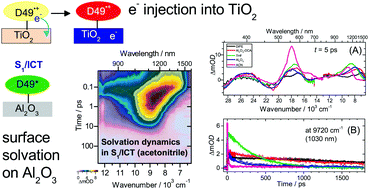Excited-state relaxation of the solar cell dye D49 in organic solvents and on mesoporous Al2O3 and TiO2 thin films†
Abstract
We present an ultrafast UV-Vis-NIR transient absorption study of the donor–acceptor solar-cell dye D49 in diisopropyl ether, THF and acetonitrile, as well as on mesoporous Al2O3 and TiO2 thin films. Photoexcitation at 505 nm initially populates the first electronically excited state of the dye having significant intramolecular charge transfer character (“S1/ICT”). On Al2O3 and in the three organic solvents, the dynamics are fully explained in terms of S1/ICT stabilisation (by reorientation of adjacent solvent or D49 molecules and collisional cooling), intramolecular vibrational redistribution and S1/ICT → S0 electronic decay. A substantial decrease of the S1/ICT lifetime is observed with increasing polarity of the surrounding medium suggesting an acceleration of internal conversion. In agreement with these results, the addition of the nonpolar co-adsorbent deoxycholic acid (DCA) to the Al2O3 surface leads to a substantial increase of the S1/ICT lifetime. DCA spacers reduce the local polarity around the dye molecules, thus interrupting D49 “self-solvation”. These results are in contrast to a recent experimental study for the indoline dye D131 on Al2O3, where charge transfer from electronically excited D131 to adjacent dye molecules was proposed (Cappel et al., Sci. Rep., 2016, 6, 21276). We do not see evidence for charge transfer processes between D49 molecules and also not for electron injection from D49 into Al2O3 trap states. Charge separation is only observed for D49 bound to TiO2 thin films, with efficient injection of electrons into the conduction band of the semiconductor via formation of a [D49˙+⋯e−] complex and a transient Stark effect signalling the formation of mobile electrons upon dissociation of the complex.


 Please wait while we load your content...
Please wait while we load your content...